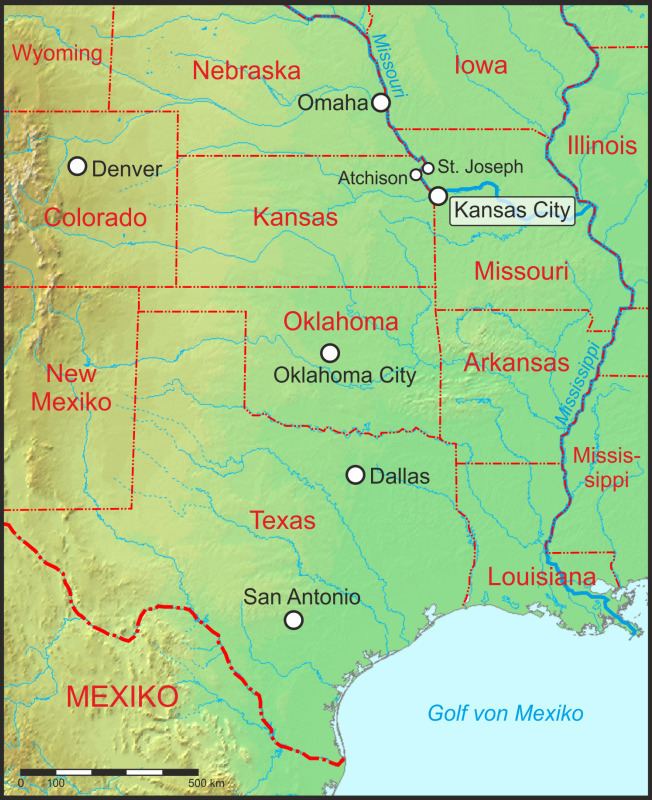Cultural origins 1920s | Derivative forms Bebop | |
 | ||
Typical instruments | ||
Kansas City jazz is a style of jazz that developed in Kansas City, Kansas and Kansas City, Missouri and the surrounding Kansas City Metropolitan Area during the 1930s and marked the transition from the structured big band style to the musical improvisation style of Bebop. The hard-swinging, bluesy transition style is bracketed by Count Basie who in 1929 signed with the Bennie Moten's Kansas City Orchestra and Kansas City native Charlie Parker who was to usher in the Bebop style in the 1940s. According to a Kansas City website, "While New Orleans was the birthplace of jazz, America's music grew up in Kansas City". Kansas City is known as one of the most popular "cradles of jazz". Other cities include New Orleans, Chicago, St. Louis, Pittsburgh and New York City.
Contents
Background
The first band from Kansas City to acquire a national reputation was the Coon-Sanders Original Nighthawk Orchestra, a white group which broadcast nationally in the 1920s. However, the Kansas City jazz school is identified with the black bands of the 1920s and 1930s.
Kansas City in the 1930s was very much the crossroads of the United States resulting in a mix of cultures. Transcontinental trips at the time whether by plane or train often required a stop in the city. The era marked the zenith of power of political boss Tom Pendergast. Kansas City was a wide open town with liquor laws and hours totally ignored and was called the new Storyville. Most of the jazz musicians associated with the style were born in other places but got caught up in the friendly musical competitions among performers that could keep a single song being performed in variations for an entire night. Often members of the big bands would perform at regular venues earlier in the evening and go to the jazz clubs later to jam for the rest of the night.
Claude Williams described the scene:
Kansas City was different from all other places because we'd be jamming all night. And [if] you come up here ... playing the wrong thing, we'd straighten you out.Clubs were scattered throughout city but the most fertile area was the inner city neighborhood of 18th Street and Vine.
Among the clubs were the Amos 'n' Andy, Boulevard Lounge, Cherry Blossom, Chesterfield Club, Chocolate Bar, Dante's Inferno, Elk's Rest, Hawaiian Gardens, Hell's Kitchen, the Hi Hat, the Hey Hey, Lone Star, Old Kentucky Bar-B-Que, Paseo Ballroom, Pla-Mor Ballroom, Reno Club, Spinning Wheel, Street's Blue Room, Subway, and Sunsetx.
Style
Kansas City jazz is distinguished by the following musical elements:
Aftermath
Kansas City influence overtly transferred to the national scene in 1936 when record producer John H. Hammond cemented his career by discovering Kansas City talent, in the shape of Count Basie.
Pendergast was to be convicted of income tax evasion in 1940 and the city cracked down on the clubs effectively ending the era.
Beginning in the 1970s Kansas City has attempted to celebrate the heritage by taking off the rough edges for family friendly environments. In the 1970s, the city tried to create a jazz enclave in the River Quay area on the Missouri River in the City Market neighborhood. Three of the clubs were bombed during a mob war that ultimately also led to the demise of mob influence of Las Vegas casinos that was depicted in the 1995 movie Casino.
In 1979, Bruce Ricker filmed The Last of the Blue Devils, a documentary starring Basie and singer Big Joe Turner, and featuring many performers from the original era.
In 1981 114 people died in the Hyatt Regency walkway collapse in an attempted recreation of the jazz scene during a tea dance.
In 1996 Kansas City native Robert Altman released the film Kansas City depicting the Kansas City jazz era.
In 1997 the American Jazz Museum opened in the 18th and Vine neighborhood with a mission of celebrating Kansas City's jazz heritage.
Each year Kansas City celebrates "Jazzoo" - a charity fundraiser dedicated to Kansas City jazz and raising funds for the Kansas City Zoo. In 2011, Jazzoo was one of the Nation's largest charity fundraisers, raising over $800,000.
Musicians
Selected discography
Early jazz and swing era music:
